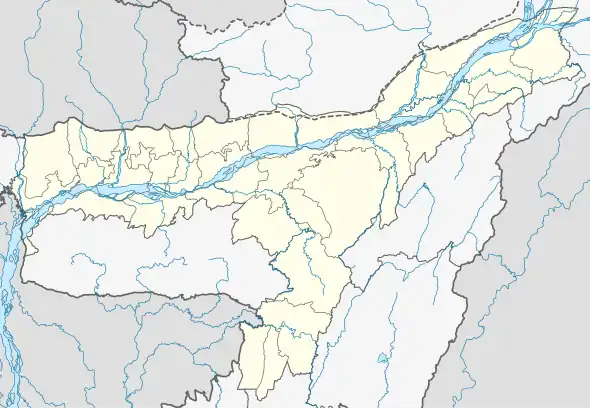Moran Town
Moran Town is a census town in Dibrugarh district in the Indian state of Assam. Moran is an important industrial town in India. It is a major oil field and a major tea-producing area.
Moran Town | |
|---|---|
Town | |
 Moran Town Location in Assam, India  Moran Town Moran Town (India) | |
| Coordinates: 27.18°N 94.93°E | |
| Country | |
| State | Assam |
| District | Dibrugarh |
| Elevation | 97 m (318 ft) |
| Population (2001) | |
| • Total | 6,784 |
| Languages | |
| • Official | Assamese |
| Time zone | UTC+5:30 (IST) |
Etymology
The name "Moran" is actually the shortened form of "Moran-hat". The place used to be a trade centre where the people from Moran tribe used to visit in order to sell their products in the north of Dihing which was located in the Chutiya kingdom. It is from this centre that "Moran-hat" derives its name.
History
The area known as Moranhat located in the Sibsagar district is of great historical significance in Upper Assam. The place got its name from the market (hat in Assamese) set up by the people of Moran tribe in ancient times. The geographical condition of the region was very different from today in those times. At that time, the Dihing river flowed south of present-day Moranhat and Sepon region as the Disoi, had the rivers Disang and Dikhou as its tributaries, ultimately joining the Brahmaputra in Mahuramukh(Bokakhat) and Lakhou(Kaliabor). At a later period (probably late 16th century), this stream of the Dihing dried out and the Dihing took another course to the north. This led to the overflow of water in the Brahmaputra to the north and the previously dried out course of Dihing was taken up by the Brahmaputra which lead to the formation of Majuli island.[1] The people of the Moran tribe lived to the south of the Dihing(Diroi) while the Chutia people lived north of the Dihing. The Morans often crossed the Dihing and set up their markets in Moranhat. Finally, after the fall of Chutia kingdom, the region was occupied by the Ahoms whose king Suhungmung built his capital in Bokota near the banks of the Dihing river. Before that, the queen of Tyao Khamti also fled the Ahom kingdom by crossing the Dihing and reached Habung while further shows the geographical condition of that time.
Geography
Moran is located at 27.18°N 94.93°E.[2] It has an average elevation of 97 m (318 ft).
Demographics
As of 2001 India census,[3] Moran Town had a population of 6784. Males constitute 53% of the population and females 47%. Moran Town has an average literacy rate of 84%, higher than the national average of 59.5%: male literacy is 86%, and female literacy is 81%. In Moran Town, 10% of the population is under 6 years of age.
Government
Moran is part of Dibrugarh (Lok Sabha constituency).[4]
References
- Research paper on formation of Majuli
- Falling Rain Genomics, Inc - Moran
- "Census of India 2001: Data from the 2001 Census, including cities, villages and towns (Provisional)". Census Commission of India. Archived from the original on 16 June 2004. Retrieved 1 November 2008.
- "List of Parliamentary & Assembly Constituencies" (PDF). Assam. Election Commission of India. Archived from the original (PDF) on 4 May 2006. Retrieved 6 October 2008.